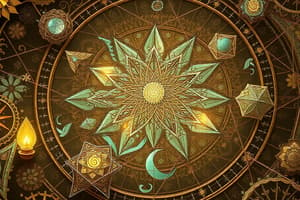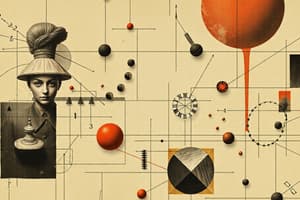Podcast
Questions and Answers
Which of the following is a core area of study in mathematics?
Which of the following is a core area of study in mathematics?
- Biology
- History
- Quantity (correct)
- Literature
What is applied mathematics primarily concerned with?
What is applied mathematics primarily concerned with?
- Applying mathematical knowledge to other fields (correct)
- Studying mathematics for its own sake
- Memorizing mathematical formulas
- Developing new mathematical theories without practical use
What concept is considered central to mathematics?
What concept is considered central to mathematics?
- Estimation
- Guessing
- Proof (correct)
- Approximation
Which civilization used math for surveying and construction?
Which civilization used math for surveying and construction?
Who introduced mathematical rigor through the axiomatic method and proofs?
Who introduced mathematical rigor through the axiomatic method and proofs?
Which numeral system allowed mathematics to develop at an accelerated pace?
Which numeral system allowed mathematics to develop at an accelerated pace?
Who developed calculus and used it to formulate laws of motion and gravitation?
Who developed calculus and used it to formulate laws of motion and gravitation?
Which branch of mathematics deals with the study of continuous change?
Which branch of mathematics deals with the study of continuous change?
Which symbol represents 'greater than' in mathematical notation?
Which symbol represents 'greater than' in mathematical notation?
What is a statement that is assumed to be true without proof called?
What is a statement that is assumed to be true without proof called?
Flashcards
What is Mathematics?
What is Mathematics?
The study of quantity, structure, space, and change.
Applied Mathematics
Applied Mathematics
Applies mathematical knowledge to other disciplines like science and engineering.
Pure Mathematics
Pure Mathematics
Studies math for the sake of math itself, not for its applications.
What is a Proof?
What is a Proof?
Signup and view all the flashcards
Arithmetic Definition
Arithmetic Definition
Signup and view all the flashcards
Algebra Definition
Algebra Definition
Signup and view all the flashcards
Geometry Definition
Geometry Definition
Signup and view all the flashcards
Trigonometry Definition
Trigonometry Definition
Signup and view all the flashcards
Calculus Definition
Calculus Definition
Signup and view all the flashcards
Axioms
Axioms
Signup and view all the flashcards
Study Notes
- Mathematics is the study of topics such as quantity (numbers), structure, space, and change
- There is a range of views among mathematicians and philosophers as to the exact scope and definition of mathematics
- Mathematics is used throughout the world as an essential tool in many fields, including natural science, engineering, medicine, finance, and social science
- Applied mathematics applies mathematical knowledge to other fields
- Pure mathematics studies mathematics for its intrinsic interest
- The concept of proof is central to mathematics
History
- The history of mathematics stretches back thousands of years
- Mathematical methods evolved from counting, measuring, and describing the shapes of objects
- Ancient Egyptians used math for surveying and construction, including basic arithmetic, algebra and geometry
- Ancient Mesopotamians developed a numeral system and could solve algebraic equations
- Greek mathematics refined the methods and expanded the subject matter
- Key Greek mathematicians: Thales, Euclid, Archimedes, and Pythagoras
- The Elements by Euclid introduced mathematical rigor through axiomatic method and proofs
- Indian mathematics made key contributions to the numeral system and algebra
- With the development of the Hindu–Arabic numeral system using a positional notation and zero, mathematics started to develop at an accelerated pace
- Islamic scholars preserved Greek mathematical knowledge and made advancements, particularly in algebra
- During the Renaissance in Europe, there was rapid development in mathematics and science
- 17th century saw innovations such as analytic geometry and calculus
- Isaac Newton used calculus to formulate laws of motion and gravitation
- 18th century saw work on differential equations and new techniques for solving them
- Leonhard Euler standardized mathematical notations
- 19th century saw the rise of abstract algebra and efforts to formalize all of mathematics
- Key figures in 19th century math: Carl Friedrich Gauss, Niels Henrik Abel, and Évariste Galois
- At the International Congress of Mathematicians in 1900, David Hilbert presented a list of 23 unsolved problems that drove much of 20th-century mathematics
- In the 20th century, mathematics became increasingly specialized
Subdisciplines
- Arithmetic: Elementary branch dealing with numbers and basic operations like addition, subtraction, multiplication, and division
- Algebra: Studies mathematical symbols and the rules for manipulating these symbols
- Geometry: Deals with shapes, sizes, relative positions of figures, and the properties of space
- Trigonometry: Studies relationships between angles and sides of triangles
- Calculus: Deals with the study of continuous change, rates of change, and accumulation
- Statistics: Deals with the collection, analysis, interpretation, presentation, and organization of data.
- Probability: Deals with the likelihood of an event occurring
- Set theory: Branch of mathematical logic that studies sets
- Topology: Studies the properties of spaces that are preserved under continuous deformations
Mathematical Notation
- Mathematical notation consists of symbolic representations used to represent mathematical objects and ideas
- Notation can be used for relatively simple operations, such as +, −, ×, ÷
- Variables are symbols that represent a quantity that can change or vary
- Formulas are equations that express a relationship between different quantities
- Examples of mathematical notation and symbols:
-
- for addition
-
- for subtraction
- = for equality
- > for greater than
- < for less than
-
Proofs
- Proofs are ways to demonstrate that certain statements are necessarily correct
- Mathematical proofs use logic and reasoning to establish the truth of a statement
- Axioms are statements that are assumed to be true without proof
- Theorems are statements that have been proven to be true using axioms and previously proven theorems
- Common proof techniques:
- Direct proof: The conclusion is shown to be true directly from the axioms, definitions, and previous theorems
- Proof by contradiction: It is shown that if the statement were false, a contradiction would result, implying that the statement must be true.
- Proof by induction: Used to prove statements about all natural numbers. It involves showing that the statement is true for the base case (usually 0 or 1), and then showing that if the statement is true for some natural number n, it must also be true for n+1.
Applications
- Mathematics is used in almost every field
- Physics uses math to describe the laws of the universe
- Engineering uses math to design infrastructures like bridges and buildings
- Computer science uses math to develop algorithms and software
- Economics uses math to model economic systems
- Finance uses math to price assets and manage risk
- Cryptography uses math to encrypt and decrypt data
- Statistics allows us to analyze and interpret data
Studying That Suits You
Use AI to generate personalized quizzes and flashcards to suit your learning preferences.



